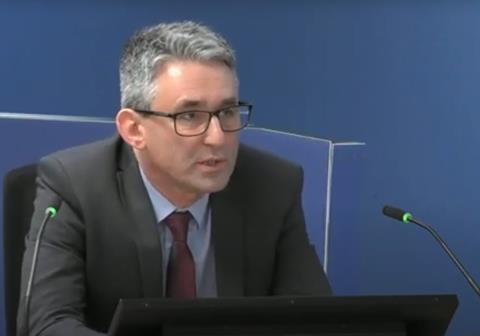Grenfell Inquiry hears the 2008 test had failed within 15 minutes with ‘flames coming off the top of the test rig’
Kingspan threatened a cladding firm with legal action if it revealed the results of a failed fire test, the Grenfell Inquiry has heard.
John Lewis, a fire engineer at building control firm the National House Building Council (NHBC), told Monday’s hearing that the threat was made after a test of a cladding system containing Kingspan’s K15 insulation failed within 15 minutes.
Lewis had learned of the failed 2008 test during a meeting with cladding firm Sotech, whose 2mm aluminium panels had been used in the system tested by the Building Research Establishment (BRE), a testing house.
Although never specified in the refurbishment project for Grenfell tower, Kingspan’s K15 insulation was found to have been included in the building’s cladding system after the 2017 fire which claimed 72 lives.
It was also being used routinely in high rise projects across the UK in the years before the fire, using an inaccurate certificate from building control group Local Authority Building Control (LABC) which suggested the product was a “material of limited combustibility”.

Yesterday, the inquiry was shown a 2015 email exchange between Lewis and another building control body in which Lewis relayed what he had heard about the failed test, which had been funded by both Kingspan and Sotech.
He said Sotech’s panels had held approval when tested with Rockwool insulation but had “failed within 15 minutes with ‘flames coming off the top of the test rig ’.”
He added: “Sotech got a call from Kingspan telling them that they’d take legal action against them if they released the test report.”
He went on to say in the email that Kingspan had “never mentioned” the failed test to the NHBC and had been “reluctant” to undertake another test using aluminium panels when the NHBC had requested it.
And he said he had seen assessments from the BRE which had extrapolated the results of tests on K15 using terracotta panels with those using aluminium.
Lewis said: “Either BRE have ignored (or been instructed to ignore) the earlier Sotech test or, as it was some time ago, the current staff are unaware of it.
“I still have doubts about how the fire performance of a lightweight metal has been assessed on the basis of an inert inorganic material and, knowing that Kingspan are wanting to cover up tests which they aren’t happy to share, I just have a feeling that the use of an aluminium façade and K15 may not be as good as we’re led to believe.”
Asked by counsel to the inquiry Richard Millett QC if Lewis had had “strong suspicions” by 2015 that Kingspan had been concealing failed test reports, he replied: “Yes.”
Lewis also admitted that it was a “concern” that the BRE had extrapolated results from terracotta panels to cover the performance of aluminium panels, while at the same time either ignoring or being unaware of failed tests at their own burn hall.
But Lewis said he had not sought a conversation with the BRE after the meeting with Sotech, adding that he was not aware that the friend he had emailed the information to had “done anything with it”.
The inquiry has already heard that Lewis described the LABC certificate in a November 2014 email as “garbage” and that the LABC’s Hereford branch, which issued it, “didn’t know what they were talking about”.
He had added: “It’s all an accident waiting to happen and we’re meeting with all the [plastic insulation] manufacturers to try and get something sorted.
“But, in the meantime, they continue to state that it’s fine and most [building control bodies] accept that at face value without sifting through the details.”
Asked by Millett if Lewis’ colleagues at the NHBC shared these views, Lewis replied: “Everyone at NHBC knew that this was not a good situation.”
But Lewis said the NHBC had continued to accept the use of K15 in high rise projects because to reject it would have “created a storm in the industry”.
Lewis said: “NHBC needed to be mindful, you know, if it was going to make that storm, then it wanted to be clear that it was necessary and would have been done.
“I think one point which we at the NHBC did have in mind at the time was that, legally , if NHBC was not prepared to accept the building with K15 on it, then that meant we would not be able to issue a final certificate and the regulatory process meant that then those schemes would have to revert back to [LABC] for them to taken enforcement action.
“We had in the back of our minds that LABC had a certificate accepting it as a material of limited combustibility and were generally accepting buildings with this material on it, and so we were kind of thinking: well, is there a great deal of point in rejecting them and sending them back to the local authority if they’re likely to still only get approved under the local authority’s ways of doing things?”
The inquiry heard in November 2020 that Kingspan had threatened the NHBC with legal action on the grounds of defamation after the body had discovered that K15 was not compliant with building regulations.
Kingspan had instructed lawyers in February 2015 to send a letter to the NHBC warning that it would seek a legal injunction after the NHBC had told the firm that it would start telling projects that had used K15 that it was not compliant.
In 2016, a year before the Grenfell fire, the NHBC published guidance confirming that K15 could in fact be used on buildings above 18m.
The inquiry continues.



























No comments yet